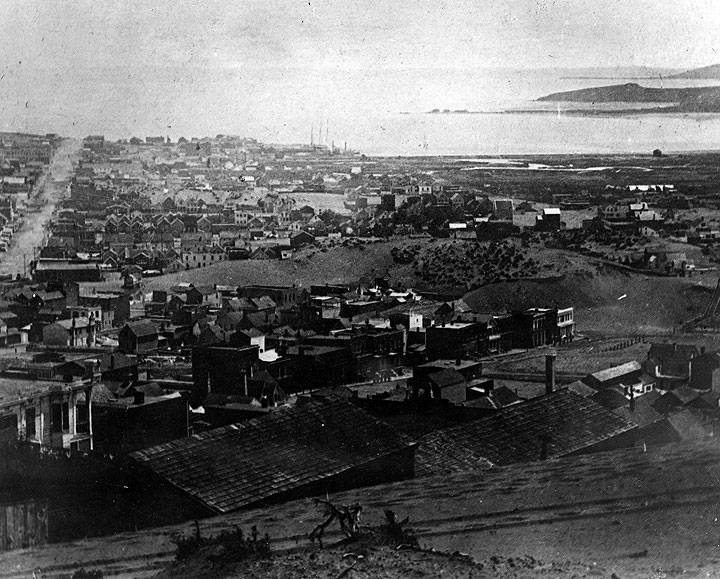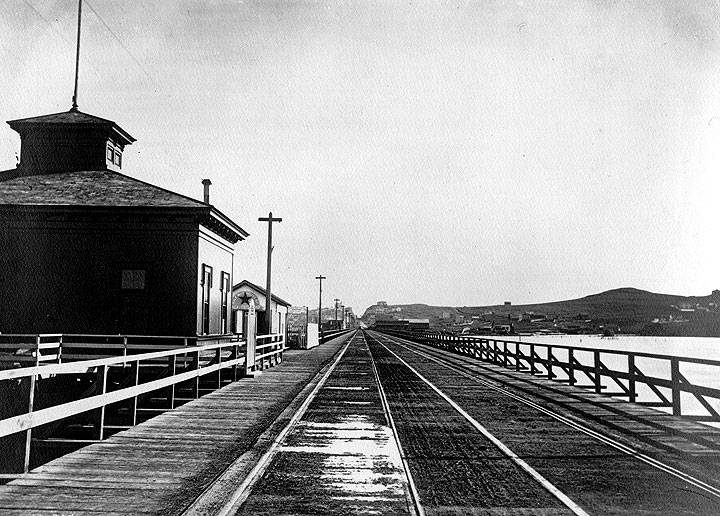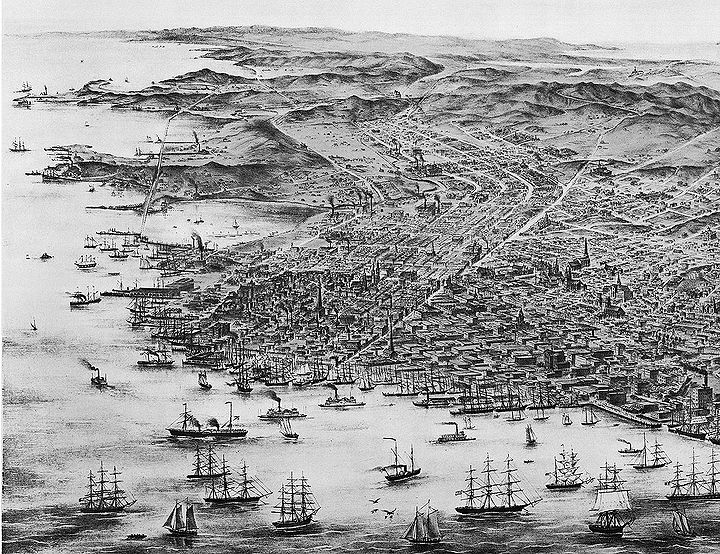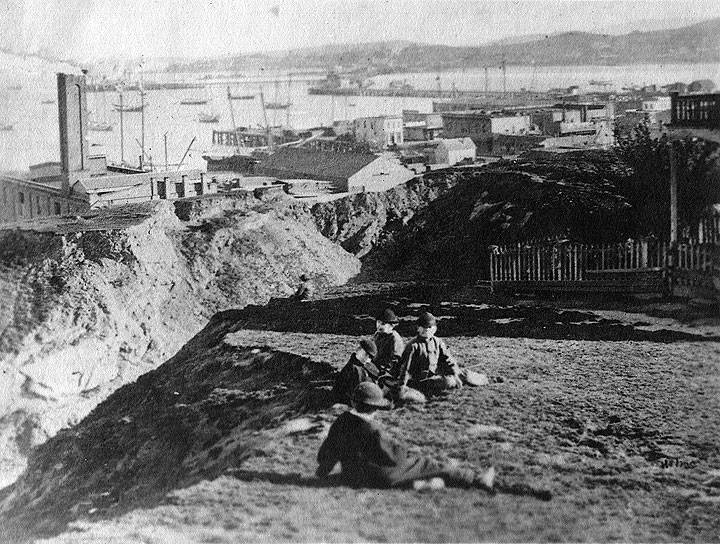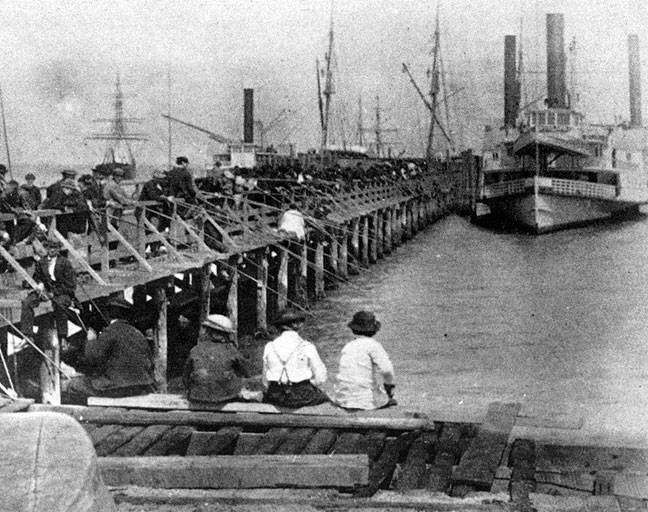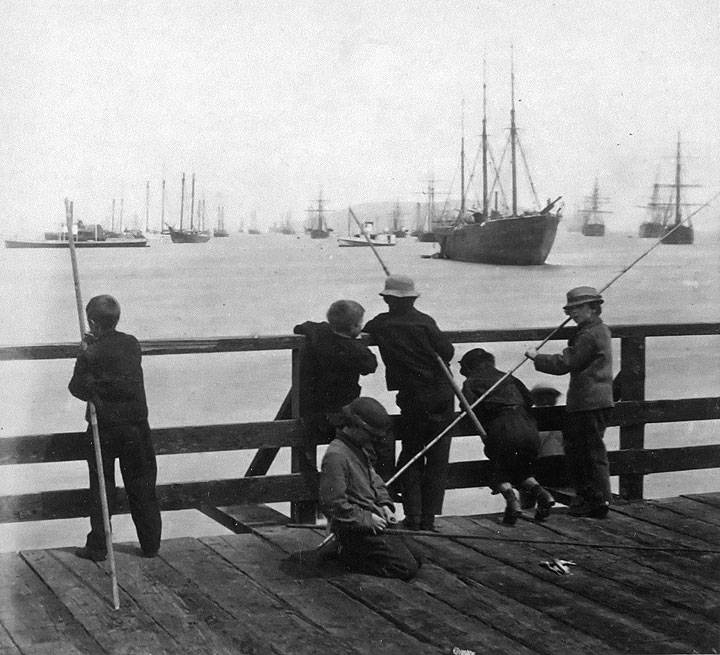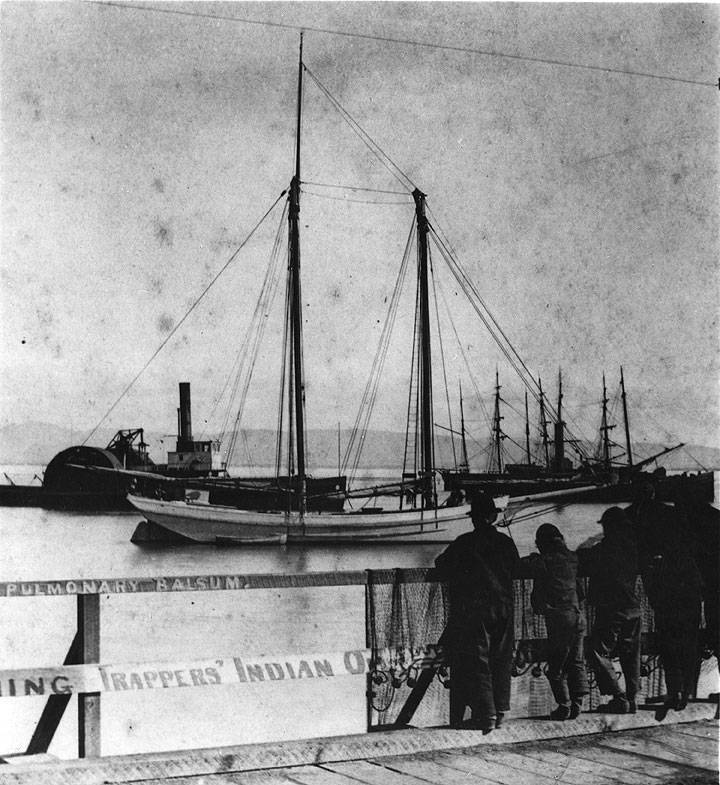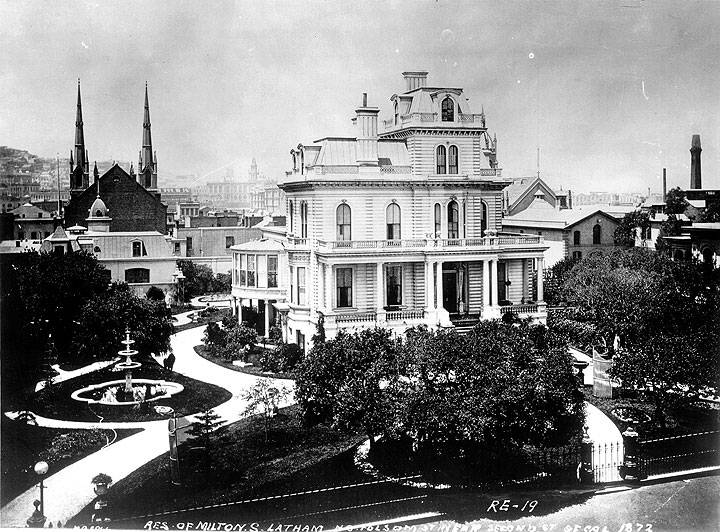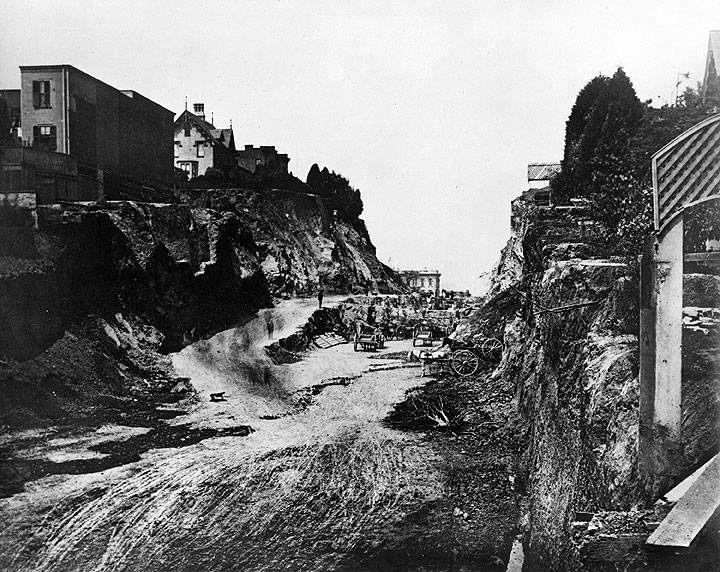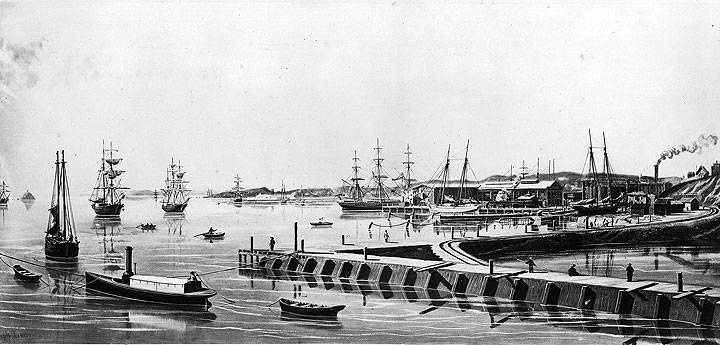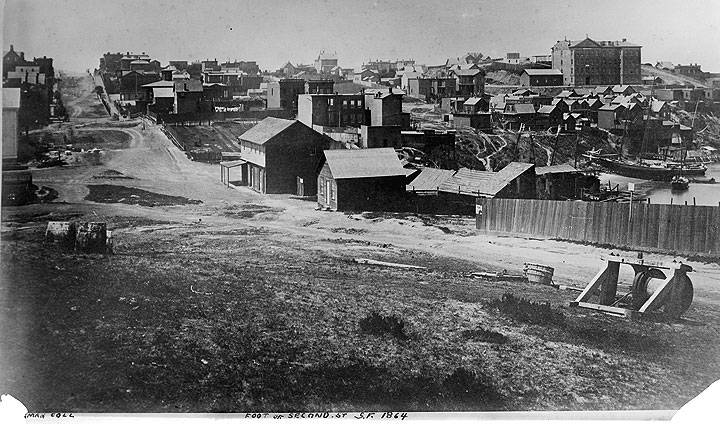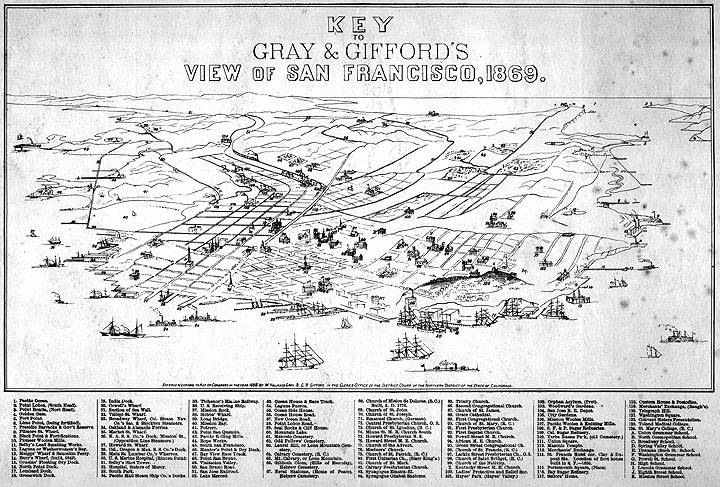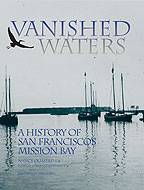The Silver Era, 1860-1870: Difference between revisions
No edit summary |
(added links) |
||
| Line 18: | Line 18: | ||
Allowing for hyperbole, the ''Alta''’s description of the city’s growth along the waterfront to the south is correct and useful. “Cribbing” consisted of constructing heavy, wooden, criss-crossed racks to hold rocks in place as the base for fill in the soft mud of Mission Bay. Sand and softer earth were then dumped on top of the rock-piled cribs, all in an effort to stem the tidal sweep. | Allowing for hyperbole, the ''Alta''’s description of the city’s growth along the waterfront to the south is correct and useful. “Cribbing” consisted of constructing heavy, wooden, criss-crossed racks to hold rocks in place as the base for fill in the soft mud of Mission Bay. Sand and softer earth were then dumped on top of the rock-piled cribs, all in an effort to stem the tidal sweep. | ||
Because Mission Bay was filled over a long period of time—from 1860 to as late as 1910—the material came from many sources. First leveled was the 100-foot sandhill on Townsend Street, then the steam paddy dumped sand and dirt taken from Fourth, Fifth and Sixth streets and from south of Market to the bay. The rock and dirt taken from the Second Street cut in 1869 was used. The serpentine rock from [[Irish Hill then and now|Irish Hill]] was blasted away and dumped into both Mission Bay and [[Islais Creek Remembered|Islais Cove]]. From the 1870s to the 1890s there was continuous casual filling from garbage dumps along the line of Seventh and Eight streets, near Berry. Finally, the earthquake rubble from 1906 completed the job, although watery puddles remained to be filled-in even later. | Because Mission Bay was filled over a long period of time—from 1860 to as late as 1910—the material came from many sources. First leveled was the 100-foot sandhill on Townsend Street, then the steam paddy dumped sand and dirt taken from Fourth, Fifth and Sixth streets and from south of Market to the bay. The rock and dirt taken from the [[2nd St. Cut|Second Street cut]] in 1869 was used. The serpentine rock from [[Irish Hill then and now|Irish Hill]] was blasted away and dumped into both Mission Bay and [[Islais Creek Remembered|Islais Cove]]. From the 1870s to the 1890s there was continuous casual filling from garbage dumps along the line of Seventh and Eight streets, near Berry. Finally, the earthquake rubble from 1906 completed the job, although watery puddles remained to be filled-in even later. | ||
[[Image:Muybridge-Long-Bridge-aad-1531.jpg]] | [[Image:Muybridge-Long-Bridge-aad-1531.jpg]] | ||
| Line 38: | Line 38: | ||
''Image: [http://www.davidrumsey.com David Rumsey Map Collection]'' | ''Image: [http://www.davidrumsey.com David Rumsey Map Collection]'' | ||
Constructed in anticipation of the expected business boom of the railroad, Long Bridge provided “rapid transit” for workmen from the city to the Potrero and | Constructed in anticipation of the expected business boom of the railroad, Long Bridge provided “rapid transit” for workmen from the city to the [[Reshaping Potrero Hill|Potrero]] and [[Hunter's_Point_Naval_Shipyard|Hunter's Point]], formerly reached only by boat or circuitous roads. On Sundays, Long Bridge became the focal point for south-of-Market fun. Smelt fishing from the long causeway was so popular that elbowroom was at a premium. The city’s rowing clubs found the broad, sunny expanse of Mission Bay ideal for races and built their boathouses on pilings next to the bridge. There were boats for rent to row out to Mission Rock, and salt-water bathhouses built right out over the bay. | ||
The recreational appeal of Long Bridge was not limited to the south-of-Market working class. The San Francisco Yacht Club’s building was at the corner of Long Bridge and Steamboat Pier at the time that Henry B. Platt was commodore and W. H. Davis was secretary of the club. With the clubhouse at hand, yachtsmen moored their boats nearby, as can be seen in the Muybridge view of the ''Emerald''. The ''Emerald'', an elegant sloop, won the San Francisco Yacht Club’s first regatta. Next to the clubhouse, James Gallandett and G.W.Purdy opened a halfway house, confident that a day on the bay would raise many a thirst. | The recreational appeal of Long Bridge was not limited to the south-of-Market working class. The San Francisco Yacht Club’s building was at the corner of Long Bridge and Steamboat Pier at the time that Henry B. Platt was commodore and W. H. Davis was secretary of the club. With the clubhouse at hand, yachtsmen moored their boats nearby, as can be seen in the Muybridge view of the ''Emerald''. The ''Emerald'', an elegant sloop, won the San Francisco Yacht Club’s first regatta. Next to the clubhouse, James Gallandett and G.W.Purdy opened a halfway house, confident that a day on the bay would raise many a thirst. | ||
Revision as of 18:50, 24 January 2011
Historical Essay
by Nancy J. Olmsted
Mission Bay from Nob Hill, 1863. Swamps and tidal inlets are still visible at the edge of Mission Bay, with Potrero Point the promontory jutting into the bay behind Mission Bay. Note the tall sand dunes still covered in scrub in foreground and middle distance. Third Street runs to Steamboat Point at left edge of photo.
Photo: San Francisco History Center, San Francisco Public Library (aad-2292)
The Look of the Land — Long Bridge Spans the Bay
“This city is growing southward,” reported the Alta California on May 2, 1864.
“A year ago the waters of the southern bay dashed against a bleak and lonely front, stretching from a rocky barren and forlorn ridge, for a distance of half a mile or more. Since then, what a change! The foot of Third Street is now the terminus of the Omnibus Railway, and the hotel whose enterprising proprietor, Farr, has done so much for excavating that thoroughfare to bring cars to the bay waters, is reaping a rich reward for his exertions. Steamboat Point which was but four years ago almost uninhabited waste is now covered with manufactories, shops, saloons and dwellings. . . . on the foot of Third Street the Citizens Gas Company is engaged in an immense enterprise, which when fully carried out must involve an expenditure of one million dollars. This company’s land is bounded by Townsend, Second and Berry. They have two lots of 275 feet. In the rear of this front is a precipitous bank of soft rock and dirt, presenting a face towards the bay of 100 feet in height. From this cliff the earth is obtained for filling up the water lots below. At the present, some 75 hands are employed in working into the cliff and carting the rock and dirt to the beach below. Laborers are industriously engaged in ‘cribbing’ the waterfront lots and filling in the bank. . . Nature has done much for this enterprise. The precipitous cliff overhanging the bay affords ample materials in way of stone and earth for filling the water lots whilst the shallowness of the waters permits the powerful steam engines to keep otherwise submerged lands dry.”
Allowing for hyperbole, the Alta’s description of the city’s growth along the waterfront to the south is correct and useful. “Cribbing” consisted of constructing heavy, wooden, criss-crossed racks to hold rocks in place as the base for fill in the soft mud of Mission Bay. Sand and softer earth were then dumped on top of the rock-piled cribs, all in an effort to stem the tidal sweep.
Because Mission Bay was filled over a long period of time—from 1860 to as late as 1910—the material came from many sources. First leveled was the 100-foot sandhill on Townsend Street, then the steam paddy dumped sand and dirt taken from Fourth, Fifth and Sixth streets and from south of Market to the bay. The rock and dirt taken from the Second Street cut in 1869 was used. The serpentine rock from Irish Hill was blasted away and dumped into both Mission Bay and Islais Cove. From the 1870s to the 1890s there was continuous casual filling from garbage dumps along the line of Seventh and Eight streets, near Berry. Finally, the earthquake rubble from 1906 completed the job, although watery puddles remained to be filled-in even later.
Long Bridge, 1867. Muybridge made this view for the then-popular three-dimensional stereopticon viewers found in most Victorian parlors. The dramatic illusion of horsecar tracks meeting in the distance made the Potrero seem even further removed from the city than it was. Gallandett and Purdy’s Half-Way House, with a star over the front door, is on the left. The larger, adjacent house in the foreground may be their home, as they are listed in the city directory as residing on Long Bridge. Dimly seen on the right are fences for the Mission Bay oyster beds belonging to the Morgan Oyster Company.
Photo: San Francisco History Center, San Francisco Public Library (aad-1531)
Long Bridge
The most dramatic evidence of the city’s southern expansion can be seen in the birdseye view of 1868—Long Bridge made the connection. Piles were driven for the bridge in February 1865, and the Potrero span was completed in 1867. Long Bridge followed the line of Fourth Street, where it made a nearly right-angle turn, spawned Hobbs Wharf reaching east into deep water, across the entrance to the Islais estuary and south towards Hunters Point. As can be seen in Gifford’s highly accurate view, Long Bridge effectively enclosed three-fourths of Mission Bay. A drawbridge at Fourth Street enabled scow schooners and other shallow-drafted craft to enter Mission Bay, but only at high tide. With the aid of the numbered key (at bottom) it is possible to locate the Shot Tower on First Street, near the large square of the Oriental Warehouse, one of the few buildings shown here that is still intact. In the cove at the foot of Second Street is a full-rigged ship on Tichenor’s marine railway. Nearby, the plume of smoke is from the new gasworks. The small bump outside Mission Bay is Mission Rock and the smokestack on Potrero Point is part of the Pacific Rolling Mills. The Rope Walk is seen to the south, with its 1,000-foot shed extending to a wharf with a small two-masted schooner alongside. In the far south is Hunters Point Drydock, and inland is the Bay View Racetrack—the effective end of the line for the Bay View Railroad that operated horsecars on the iron tracks on Long Bridge.
Gray and Gifford’s Birdseye View of San Francisco, 1868. Diagramatic view with keyed code may be found at bottom of this screen.76
Image: David Rumsey Map Collection
Constructed in anticipation of the expected business boom of the railroad, Long Bridge provided “rapid transit” for workmen from the city to the Potrero and Hunter's Point, formerly reached only by boat or circuitous roads. On Sundays, Long Bridge became the focal point for south-of-Market fun. Smelt fishing from the long causeway was so popular that elbowroom was at a premium. The city’s rowing clubs found the broad, sunny expanse of Mission Bay ideal for races and built their boathouses on pilings next to the bridge. There were boats for rent to row out to Mission Rock, and salt-water bathhouses built right out over the bay.
The recreational appeal of Long Bridge was not limited to the south-of-Market working class. The San Francisco Yacht Club’s building was at the corner of Long Bridge and Steamboat Pier at the time that Henry B. Platt was commodore and W. H. Davis was secretary of the club. With the clubhouse at hand, yachtsmen moored their boats nearby, as can be seen in the Muybridge view of the Emerald. The Emerald, an elegant sloop, won the San Francisco Yacht Club’s first regatta. Next to the clubhouse, James Gallandett and G.W.Purdy opened a halfway house, confident that a day on the bay would raise many a thirst.
Boys atop Rincon Hill, c. 1870s. Long Bridge spanning mouth of Mission Bay in distance.
Photo: California Historical Society (CHS2010.292)
Small cafes and saloons perched on pilings next to the bridge where fishermen, Sunday sailors and families out for a stroll along sunny Mission Bay could stop for refreshment. Others rode the horsecars all the way to the end of the line to watch the horses run at Bay View. And there were the special Sunday excursions put on by the homestead associations, whose salesmen met the Bay View cars with their buggies and took families out on Hunters Point to inspect sites for future homes. A pleasant Sunday afternoon outing on Long Bridge had all the variety of sights, sounds, smells and activities that an urban park offers.
Smelt Fishing from Long Bridge, 1869. The South of Market Journal recalled that Hobbs Wharf, off Long Bridge, “was a great place for Sunday and holiday fishing. If one did not get there at an early hour you hadn’t a chance to drop your line. There were not many fancy fishing outfits seen then, mostly long bamboo poles. . . There were booths along the wharf where you could rent one and buy your bait. Imagine hundreds of these poles projecting out, about a yard apart. The fish caught were smelt—hundreds of these silvery, graceful fighting fish”77
Images: Bancroft Library (I0021773)
Tug Goliah Long Bridge 1870s'
Photo: Bancroft Library brk00012276_24a
Real Estate Schemes: “Cut Down Rincon Hill and Fill In Mission Bay”
“The Silver Age was an intense, booming, hopeful decade . . . Few seem to understand that the decade between 1860 and 1870 was, next to the golden age of the ‘50s, the most important in the history of California. It was the period of transition from the fierce exploitation of the pioneers who looked only on the region as a thing to be despoiled of its treasures and abandoned. It saw valleys changed into broad oceans of waving grain. It saw the foothills crowned with thrifty vineyards, saw the beginnings of systematic irrigation . . . saw a mighty foreign commerce develop, saw the treasures of the Comstock Lode unlocked, saw a railroad stretch from the Atlantic to the Pacific . . . everyone at last realized that gold was the smallest part of the state’s resources and the outlook was as broad as the horizon of mid-ocean.” 78 So wrote Asbury Harpending from a comfortable old age in 1913, looking back at the most tumultuous decade of his own life-in which real-estate ventures played no small part.
The treasure of the Comstock Lode was the major factor in what occurred. San Francisco had experienced a panic in 1855 when Harry Meiggs absconded, leaving a number of her citizens considerably worse off. The real-estate boom of 1853 leveled off and dropped as the supply of gold shipped from the mines appeared to have peaked. What had been overheated speculation cooled to something more normal, which by contrast seemed to be a depression.
With tremendous California-style luck, the discovery of the Comstock Lode of silver paid out $6 million; by 1863, the figure had doubled. In 1864 Comstock silver reached $16 million; adding its value to the gold that year, $55 million in treasure passed through San Francisco. Money continued to pour into the city, generating heavy trading in mining stocks. Then, in 1874, the Big Bonanza struck, bringing in a million dollars a day for two months.79
Montgomery Street Straight
The heady prospect of San Francisco’s peninsula becoming the terminus for the transcontinental railroad, coupled with the new flow of capital from the Comstock, injected new life into real-estate speculation, especially schemes affecting the southern waterfront. The rallying cry of real-estate promoters of the ’60s was “Montgomery Street Straight!”
The possibility of connecting the financial district by a broad avenue directly to the Potrero and Mission Bay opened dizzy possibilities for promoting real estate. The idea was to extend Montgomery Street diagonally as a wide thoroughfare to the southern part of the city, joining Connecticut Street in the Potrero to the Montgomery Street financial district. Hittel reports: “This scheme was carried through the supervisors and passed over the mayor’s veto; commissioners were appointed, and they made an elaborate report, with the estimate of the expense, but the engineer in laying off the map of the work, assumed incorrectly that the blocks intersected were exactly of the size proposed in the original survey. The consequence was that the lines of the new street were not straight, but showed a little offset like a saw-tooth at every crossing. This defeated the enterprise.”80 But another connection from the financial district to Steamboat Point had been brewing and came to a boil.
Middleton’s Move
John Middleton, an auctioneer and real-estate broker, owned a lot at Second Street and Bryant. In 1863 Middleton proposed cutting through Rincon Hill on Second Street, then the fashionable center of San Francisco’s best neighborhood. The idea was soundly put down on all sides, but Middleton persisted. He ran for the state legislature and was elected in 1868, whereupon he successfully devoted himself to getting his bill passed. San Francisco’s Mayor Thomas H. Selby refused to carry out the order; his own fancy residence was on Rincon Hill at Harrison Street. The State Supreme Court ordered that the legislative act be carried out, and in 1869 the giant earth moving took place. The original cost-estimate was $90,000, but the direct expense was $385,000. “The rock being non-cohesive, bulged downward and inward, like the filling of a swampy piece of land . . . the ground would sink . . .thereby endangering workmen by caving in.”81 As landslides endangered the houses that teetered on the edge of the muddy abyss, wealthy residents began to consider moving to the peninsula or to Oakland. Asbury Harpending looked at the problem and came up with a proposal.
Harpending’s Plan
Of the Second Street cut, he wrote, “It was a sordid bit of real-estate roguery . . . but it was an accomplished fact. . . . The old high-priced residence property was going for a song. As the ‘Hill’ had ceased to be either beautiful or useful, Ralston and I calmly proposed to pull it down. We planned to have the city buy the property, which could be purchased for $12,000,000 . . . and grade it to the Market Street level. . . . Many million cubic yards of excavated material were to be used to fill in a 150-acre tract of tide-land offered to the city by the State at a nominal price, lying between the Pacific Mail docks and Islais Creek, also to reclaim China Basin [Mission Bay], at least, in part. The cost of grading and reclamation work was estimated at $7,500,000. . . .In other words, the city was asked to issue bonds for $12,000,000 and received in payment over 200 blocks of choice property.”82
'Rincon Hill Slips Into Oblivion. The Latham mansion (above) was the $300,000 gift of Milton Latham to his bride and where they lived in fashionable splendor atop Rincon Hill. In 1869 the Second Street cut destroyed the integrity of the hill as handsome homes teetered on the brink of a sixty-foot ditch. By 1920 Rincon Hill had become a desolate slum fit only for use as the footing to the San Francisco Bay Bridge.
Photo: San Francisco History Center, San Francisco Public Library (aac-5735)
Looking North on Second Street in 1869, cutting the street through Rincon Hill, Second and Bryant Streets.
Photo: San Francisco Maritime National Historical Museum (A12.28,752n)
Harpending was delegated by his partner, William Ralston, to persuade the state legislature to put through two bills. One bill advocated Harpending’s proposal to extend his own New Montgomery Street all the way through to the bay. Harpending owned the Sutter Street gore (a triangular lot created by the diagonal line of Market Street), as well as other Market Street property. That same year he built the Harpending Block, between First and Second streets and the Grand Hotel, at the corner of Market and New Montgomery. The second bill allowed the city to acquire Rincon Hill, level it and fill-in the tidelands of Mission Bay.
Two “vote-brokers” controlled the state legislature at that time, and Harpending “casually passed $35,000 at our first interview” to these political bosses. In addition, “I practically chartered a well-known restaurant in Sacramento and threw it open to my friends.”83 With some fancy footwork that included waylaying the governor’s secretary on his way to the senate chambers bearing the governor’s veto of these two bills, Harpending got what he and Ralston wanted.
South Beach View of Mission Bay. In 1869 Joseph Lee, one of San Francisco’s best marine artists, made this meticulous study standing on the Pacific Mail Dock, looking south from the foot of First Street. The railroad spur is on the bulkhead, built to start filling the land northwest of First and Townsend. A ship is hauled up on Tichenor’s ways at the foot of Second Street, just in front of the newly completed Citizens’ Gasworks. The smokestack marks the site of the Pacific Oil and Lead Works. This view of South Beach, the northeastern boundary of Mission Bay, was made as the building boom was just underway in anticipation of the completion of the transcontinental railroad. In the distance is Potrero Point; Long Bridge is concealed by the cluster of new industries at the foot of Second Street.
Image: California Historical Society (CHS2010.286)
Furious at Harpending’s tactics, the governor refused to certify that the bills were law. Harpending took Governor Haight to court—and won.84 It would seem that the fate of Rincon Hill and Mission Bay was settled in 1870. However, Harpending left for England to fleece the London stockmarket with western mining stocks and salt a diamond mine. Ralston was preoccupied with financial complications at the Comstock mine. Other parties (perhaps Milton Latham and John Parrott, who had earlier opposed the idea of an avenue cutting across their Rincon Hill front yards) put through a legislative bill that repealed the Harpending-Ralston plan for leveling Rincon Hill to fill in Mission Bay.
Another view of the “foot of Second Street” from Steamboat Point. Martin Behrman, 1864.
Photo: California Historical Society (CHS2010.287)
This is chapter eight of "Vanished Waters: A History of San Francisco's Mission Bay" published by the Mission Creek Conservancy, and republished here with their permission.
NOTES
76. Key to Gray and Gifford's Birds-eye View:
25. Market Street Wharf;
26. N.A.S.S. [Opposition Railway Line Steamers] Mission St. Wharf; 27. Howard St. Wharf; 28. California, Oregon & Mexico S.S. Company Wharf; 29. Main Street Lumber Wharves; 30. U.S. Marine Hospital, Rincon Point; 31. Selby’s Shot Tower; 32. Sister of Mercy Hospital; 33. South Park; 34. Pacific Mail Steamship Company Dock; 35. Tichenor’s Marine; 36. U.S. Receiving Ship; 37. Mission Rock; 38. Hobbs Wharf; 39. Long Bridge; 40. Mission Bay; 41. Potrero; 42. Point San Quentin; 43. Pacific Rolling Mills; 44. Tubbs Rope Works; 45. South San Francisco; 46. Hunters Point Dry Dock;
47. Bay View Race Track
77. South of Market Journal, June 1926, p. 15.
78. Asbury Harpending, The Great Diamond Hoax and Other Stirring Incidents in the Life of Asbury Harpending (San Francisco: James H. Barry, 1915), 109.
79. J.S. Hittell, The History of the City of San Francisco. . . 365 fff.
80. Ibid. 378.
81. Langley’s San Francisco City Directory, 1870, 169.
82. Harpending, The Great Diamond Hoax. . . 147-148.
83. Ibid. 152-155.
84. California Reports, 1869 vol. 38:189.

